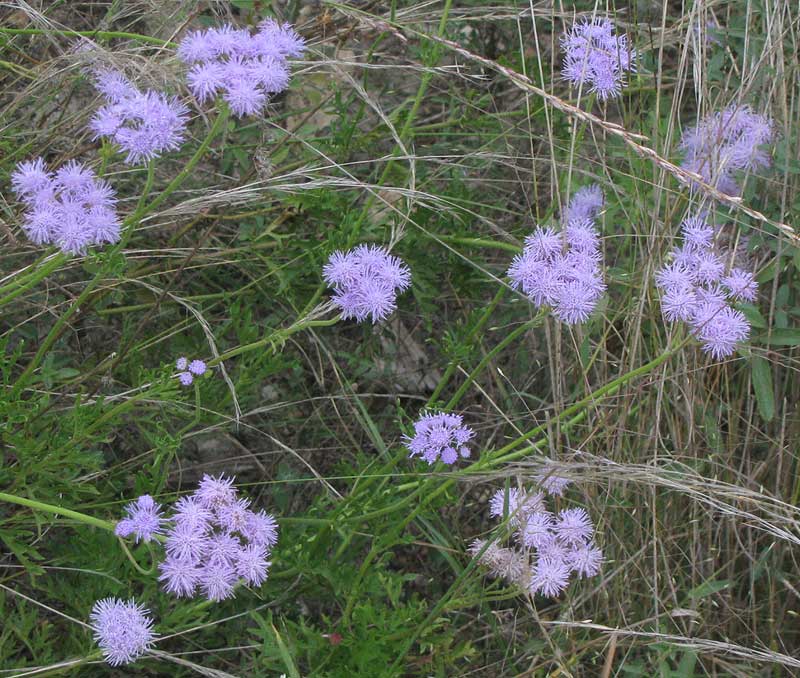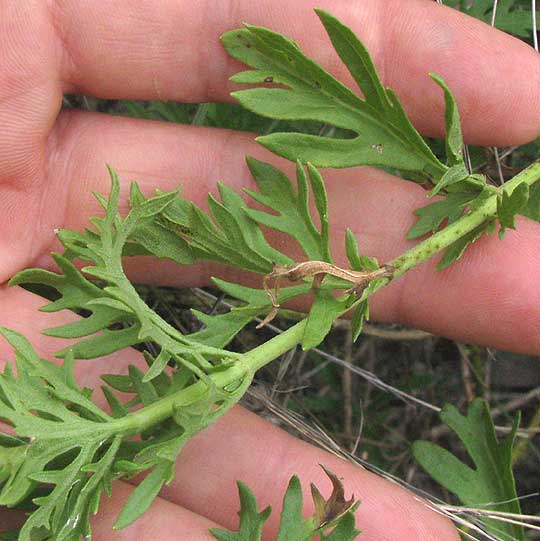Excerpts from Jim Conrad's
Naturalist Newsletter

from the the October 28, 2012 Newsletter issued from the valley of the Dry Frio River in northern Uvalde County, southwestern Texas, on the southern border of the Edwards Plateau; elevation ~1750m (~5750 ft); N29.62°, W99.86°; USA
PALMLEAF MISTFLOWER
Now that the fall Monarch Butterfly migration is winding down, on warm, sunny days -- of which there are plenty here -- you can still see lots of butterflies. There's still a few Monarchs, plus a scattering of Queens, always some Gulf and Variegated Fritillaries, Pipevine Swallowtails, Bordered Patches, and others... And maybe the best place to see butterflies is on the lower slopes of our wooded hills, in the Dry Frio's floodplain and along roadsides, where there's a lot of the blue-blossomed Composite wildflower shown above.
A flower-head close-up showing the complete absence of petal-like ray flowers, but with two slender, blue style-branches emerging from each of the closely packed disk flowers, is shown below:

Breaking open the flower head, you can see that each developing ovary, or future dry, one-seeded fruit, is topped with numerous very slender, stiff hairs or bristles, which constitute the pappus. Once the fruit is mature, the white bristles will behave like a parachute and help the fruit disseminate via the wind. Also notice that there are no papery, fingernail-like items, or paleas, separating the ovaries. These are very important field marks that help in identification. Many other similar wildflowers have different kinds of pappi, or no pappus at all, or maybe their ovaries are separated by paleas.
Folks knowing their wildflowers but not experienced in species of the US Desert Southwest may feel confident that here we're looking at the Blue Mistflower, Conoclinium coelestinum, one of eastern North America's best known and most common fall wildflowers, but it's not. A look at the deeply dissected leaves will prove that, as shown below:
 .
.
Our plant is closely related -- in the same genus, Conoclinium -- but it's found mostly in arid northern Mexico, extending into the US only in southern Arizona and New Mexico and western Texas. It's CONOCLINIUM DISSECTUM, in English known by names such as Palmleaf Mistflower, Palmleaf Thoroughwort, Purple Palmleaf Mistflower, Gregg's Mistflower, and Boothill Eupatorium.
Palmleaf Mistflower looks so at home along our roadsides that you wonder what's keeping it from expanding away from its desert and semi-desert homeland. I suppose it's a matter of its being unable to compete with species adapted for rainier regions, which in turn can't survive the extremes of our summers.
Whatever the reason, Palmleaf Mistflower adds an unexpected and very pleasing aspect to our landscape here, and the Monarchs and other butterflies active at this time of year must be very thankful for it.